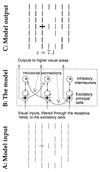Contextual influences in V1 as a basis for pop out and asymmetry in visual search
- PMID: 10468643
- PMCID: PMC17923
- DOI: 10.1073/pnas.96.18.10530
Contextual influences in V1 as a basis for pop out and asymmetry in visual search
Abstract
I use a model to show how simple, bottom-up, neural mechanisms in primary visual cortex can qualitatively explain the preattentive component of complex psychophysical phenomena of visual search for a target among distracters. Depending on the image features, the speed of search ranges from fast, when a target pops-out or is instantaneously detectable, to very slow, and it can be asymmetric with respect to switches between the target and distracter objects. It has been unclear which neural mechanisms or even cortical areas control the ease of search, and no physiological correlate has been found for search asymmetry. My model suggests that contextual influences in V1 play a significant role.
Figures





References
-
- Treisman A, Gelade G A. Cognit Psychol. 1980;12:97–136. - PubMed
-
- Julesz B. Nature (London) 1981;290:91–97. - PubMed
-
- Treisman A, Gormican S. Pyschol Rev. 1988;95:15–48. - PubMed
-
- Duncan J, Humphreys G. Psychol Rev. 1989;96:1–26. - PubMed
-
- Wolfe J M, Cave K R, Franzel S L. J Exp Psychol. 1989;15:419–433. - PubMed
Publication types
MeSH terms
LinkOut - more resources
Full Text Sources

